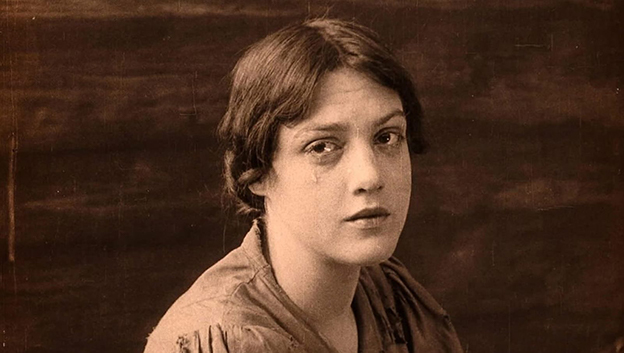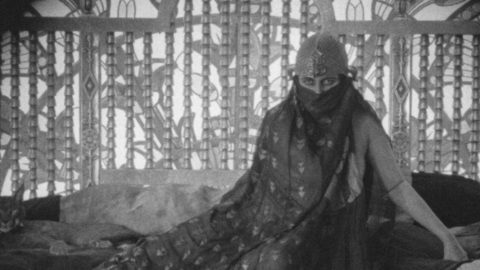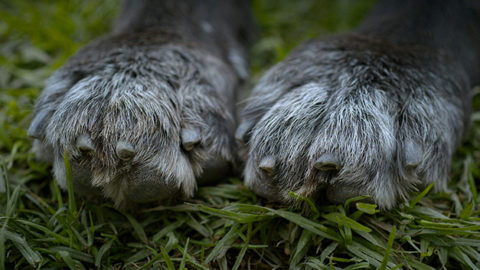Deep Focus: The Lincoln Cycle
The Lincoln Cycle screens Saturday, February 9 at Film Society of Lincoln Center as part of Film Comment Selects.

The Lincoln Cycle (1917), a series of linked two-reelers (originally 10; two are lost), toggles between Abraham Lincoln’s presidency and his boyhood in Indiana. It darts back now and then to frontier Kentucky, where his forefathers lived and he was born. With sentiment and nimble artistry, the cycle celebrates a leader who dreams of winning battles via “love and service” but who goes to war when the need is real and the cause just. As a piece of civic art, it’s a tonic for our battered national soul. As an experiment in movie as memory play (28 years before Tennessee Williams coined the term to describe The Glass Menagerie), it’s crafty and engaging. The surviving eight-part sequence screens Saturday at 2 p.m. at the Film Society of Lincoln Center, with live piano accompaniment by Donald Sosin; I previewed it without music and on a small screen. Still, its combination of popular myth-making and eccentric innovation held me rapt for 215 minutes straight.
Lead actor Benjamin Chapin spearheaded the production to showcase his popular stage incarnation of Honest Abe, putting his name on the credits as writer, director, producer, and star. He even placed his image on multiple illustrated title cards so audiences would know that he plays Lincoln, his father Thomas, and his grandfather, an earlier Abe. According to Richard Koszarski’s authoritative account in Film History (“Benjamin Chapin: The ‘Lincoln Man’ and his Lincoln Cycle”), John Stahl said he directed the picture (Stahl’s sound-era credits include 1945’s Leave Her to Heaven and the 1930s versions of Back Street, Magnificent Obsession, and Imitation of Life). Stahl also informed the press that Madelyn Clare and Charles Jackson played Nancy Hanks Lincoln (Abe’s mother) and the young Abe, respectively. (Both are terrific in modern and unmannered ways.) A clutch of writers might have pitched in on the script, notably future MGM executive Paul Bern (sadly, best known today for committing suicide while married to Jean Harlow).
Yet the film has a singular vision that’s accessible and entertaining. Recreations of landmark moments such as Nancy’s death when Abe was nine blend into fictional stories. They often start out as anecdotes and take on varied dimensions as Chapin and company replay them from unexpected perspectives. Poignancy veers into bittersweet comedy; certain tales become moral touchstones. It’s fascinating to view The Lincoln Cycle (also known as The Son of Democracy) in tandem with John Ford’s Young Mr. Lincoln (1939). Both films underline Abe’s merging of rugged pioneer strength and down-home humor and intelligence with charity, empathy, and intellect. He’s a uniter not only in his quest to preserve the union but also in his instinctive melding of traditional manly and womanly traits. These movies give the lioness’s share of credit for this synthesis to a couple of mostly undocumented females—Ann Rutledge, the love of Lincoln’s life, in Ford’s film, and Abe’s mother, Nancy, in Chapin’s. They provide the filmmakers with the dramatic means to convey the maturing of a character who’s both tough and tender.
The initial episodes of The Lincoln Cycle, “My Mother” and “My Father,” which start with the President-elect, age 52, visiting old haunts on the eve of his departure to Washington, combine to form a fable about masculine and feminine, yin and yang. In “My Mother,” Nancy despairs that her husband, Tom, hasn’t honored his promise to her that he’ll learn to read and write. As she watches him scratch his mark on a bill of sale after a cunning neighbor buys a corn sickle from him for two dollars, she resolves to teach Tom how to sign his name. He manages a few clumsy imitations of her script before he gets fed up. Then Nancy notices that in the corner, next to the fire, young Abe has picked up charcoal and scratched his name on the back of a wood shovel. It’s like the magical moment in My Left Foot when Christy Brown scrawls out “Mother” with chalk between his toes, on the kitchen floor. Destiny thrusts its way into domesticity. Nancy decides that Abe, not Tom, will fulfill her dreams. She fosters his love of books like John Bunyan’s Pilgrim’s Progress and Parson Weems’s biography of George Washington and makes him pledge that he’ll never solve his problems by fighting and he’ll always strive to be “gentle, honest, and kind.” A big tree near Abe’s preferred fishing spot becomes the place where he and his mother escape into literature. Her arm encircles him as she reads.
Clare and Jackson conjure such an ardent mother-son connection that the ground shifts beneath us, too, when Nancy succumbs to the milk sickness (caused by drinking the milk of cows who graze on snakeroot). Clare and Jackson act without theatrical excess; they know the camera lens catches every shade of thought and feeling in their faces. Nancy and Abe’s private affinity is plain for us to see; Tom simply isn’t emotionally equipped to deal with their bond. He thinks book-learning has made Abe soft. In “My Father,” Abe finally tells Tom that he backed off from recent battles with Huck Carter, a mean-spirited neighborhood scamp, because he promised Tom’s late wife and his mother he would swear off violence. The admission drops on Tom like a ten-ton epiphany. When Abe’s ability to read a contract saves Tom from signing away the family farm to Huck’s sneaky father, the boy changes in his father’s eyes from a weakling to a take-charge guy.
In Nancy’s death scene, Clare conveys the mother’s intuitive awareness of her son Abe’s emotional state: even in a mortal haze, she can tell that he’s just fought Huck. Jackson movingly quivers with shame and regret. Using a stagey gesture out of 19th-century melodrama, Jackson stretches out his arms and makes clinging motions with his hands to italicize Abe’s grief. But his emotional aim is true. Chapin deftly impersonates the legendary, older Lincoln—droll, skeptical, yet full of fellow feeling. As a true showman, his affection for Lincoln is infectious, and he builds suspense into his performance. When the President drifts into indecision, Chapin makes us wonder how long he’ll wear a wry or ponderous mask before uttering a sally or a quip, cracking a smile, or signaling his core emotions. As Tom, Chapin captures a limited man’s domestic mortification, and as Grandpa Abe, an extrovert and friend of Daniel Boone’s, he displays leathery frontier dash. When an Indian delivers a fatal bowshot, Abe’s death grimace is ugly and shocking—like the arrow, it pierces the heart.
Just as a dispersive prism breaks light into its spectral colors, Chapin and Stahl put Abe’s primal scenes through a narrative prism that splits each stop on the comic-dramatic spectrum and intensifies every emotion. In episode four, “My First Jury,” we see him spar with Huck, verbally and then physically, over Huck’s contention that a black friend, Jim, stole a chicken. It’s an uproarious rural precursor to an “Our Gang” comedy. Abe sets up, not a kangaroo court, but a dog-and-cat court, using pets and barn animals to fill out his panel. Juror #7 is a turtle. Then Abe makes a stirring speech playing on his listeners’ mother-love: Jim’s mom, he contends, is starving. Realizing that the “trial” isn’t going his way, Huck resorts to fisticuffs. It makes for a rollicking few minutes.
In episode five, “Tender Memories,” the tail end of that story gets an unexpected twist that provides it with a tragicomic impact. Abe has requested that a pastor, Reverend Elkins, preach a service at his mother’s grave. When he arrives unannounced at the Lincolns’ home, Tom directs him to the Carters’ barn, where Jim’s “trial” has gone to pieces and the boys are scrapping. Abe inadvertently elbows the minister, who naturally believes that Abe might be trying to make a fool out of him. Only the sight of the lad sobbing on Nancy’s burial mound convinces the good preacher that the Lincoln family is worth his prayers.
This film’s leadership theme resembles Black Panther’s: It’s hard for a good man to be president. The grown Lincoln struggles to follow his mother’s precepts while fiercely defending his country. Huck Carter and his dad are perfect dramatic foils for Lincoln. They depict how easy it is for grasping opportunists to slide into casual evil. Huck becomes a recruiter for the Confederate Army, signing up Dave Elkins, the reverend’s naïve son. When Dave fatally strikes one of his Union captors, he receives the death sentence for manslaughter. Lincoln, considering mercy, looks to old John Bunyan for guidance: after all, this boy “by sin has brought himself into a state of captivity and misery.” Will Lincoln deem that Dave has made his own deathbed? Or will Rev. Elkins’s past good deeds weigh in his son’s favor?
Visually, The Lincoln Cycle is handsome and limber, though it contains just one expressive camera movement—Chapin and Stahl pull back from the Lincolns’ breakfast table to show the entire household gearing up for the day. Most of the scenes, though, are beautifully blocked to let the actors breathe and play, and the cameramen (including the gifted J. Roy Hunt) frame and light the interiors in geometric sections that the unnamed editors stitch into graceful links or snap together like Lego bricks. As Roger Corman used to tell his protégés, “Cutting equals movement.” At times, cutting also equals drama. Late in the cycle, the editors return to Nancy’s demise in a shot that’s been matted to echo the shape of a proscenium stage. It makes a vivid kind of sense because here Lincoln relates the story formally, to a stranger—a soldier—not to his trusted secretary or to friends. No image like it can be found anywhere else in the movie. The film’s use of iris shots—black circles closing in and opening out—are daring and original. At one point, the iris zeroes in on Nancy while she’s deriding Tom for his illiteracy. Then it unfolds to reveal a younger Tom dangling an engagement ring before Nancy’s laughing eyes and promising to become a lettered man when he becomes her husband. It’s the iris as time machine, hurtling us into a flashback within a flashback.
We do feel the absence of the missing shorts, “Down the River” (episode eight) and “The Slave Auction” (episode nine), partly because there’s an inevitable loss of continuity, but mostly because these two lost episodes dramatize the atrocity of slavery and Lincoln’s growing opposition. The Lincoln Cycle in its present form slights Lincoln as The Great Emancipator. But it’s a gorgeous salute to Lincoln as “Father Abraham.” According to this film cycle, he learned how to be his country’s righteous patriarch by behaving like his mother’s son.
Michael Sragow is a contributing editor to Film Comment and writes its Deep Focus column. He is a member of the National Society of Film Critics and the Los Angeles Film Critics Association.





